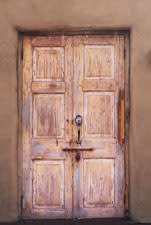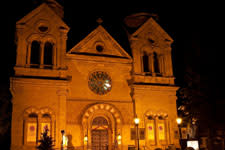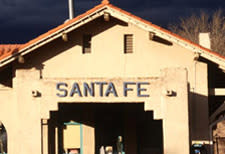Santa Fe Architecture
Santa Fe has a distinctive architectural style all its own. No other city in the country has so many low-slung, earth-colored buildings made of adobe bricks, which consist of a mixture of sun-dried earth and straw.
And though it seems as though adobe dominates the city, there's a surprising diversity of building materials and architectural styles on display, including examples of Victorian, Italianate and California Mission Revival styles. In recent years, modern architects have begun to blend elements of historic architectural styles with contemporary designs, creating a sleek new look for Santa Fe in the 21st century.
Santa Fe's unique architecture is one of the reasons for the immense popularity of this capital city, which is surrounded by majestic mountains with gentle slopes that resemble the soft curves of adobe walls. Explore the meandering streets of downtown and nearby residential neighborhoods to discover hundreds of historic adobe homes, built primarily in the Spanish Pueblo and Territorial styles. These architectural styles are rooted in ancient history and protected by city laws ensuring that new construction situated in core historic districts fits with the old.

Pueblo Style
Santa Fe's historic adobe architecture evolved from early Native American dwellings that impressed the Spanish when they first arrived in the region in the 16th century. They found Pueblo Indians in the Rio Grande Valley living in communal houses with hundreds of rooms, often four or five stories high, accommodating thousands of people.
The Spanish, who called these communities "pueblos" (the Spanish term for villages), saw how the Pueblo people built their shelters as a series of rooms surrounding a central plaza, with earth floors and flat roofs held up by pine logs, or vigas. These beams were covered diagonally or at right angles with small poles, or latillas. The Pueblo Indians built their homes using wood, stone and puddled adobe, a laborious method of molding adobe walls by hand then laying them in low bands to dry before adding the next layer.
As the Spanish settlers established communities in the region, they sought to improve the Pueblo construction methods using adobe. After all, the essential materials—mud, earth and straw—were plentiful and readily available. But to streamline the construction process, they designed wood molds to shape uniform adobe bricks.
This melding of Native American with Spanish architectural influences gave rise to the Pueblo style, also known as Spanish Pueblo. In the Spanish homes, the style's characteristic elements include round walls, corner fireplaces, vigas, flat roofs and a series of rooms fronted by covered porches, called portales, that enclosed an exterior patio, echoing the Pueblo rooms designed around a central plaza.
The Spanish often built their houses with one or two rooms then expanded them later on with additions to accommodate growing families. They installed few doors or windows in order to retain heat during the winter and maintain cool temperatures during the summer.

Greek Revival Style
By the 1900s, Pueblo style homes, with their characteristic flat roofs, could be found all over Santa Fe. But by then, architectural styles were changing, due in large part to the 1821 opening of the Santa Fe Trail and the 1846 occupation of Santa Fe by the American army. As new materials including fired bricks, mill-made windows and whitewashed posts and trim were brought to Santa Fe along the trade route, the town's façade took on a new look.
Exemplified by wood columns painted white, front porches, pitched roofs, brick copings and double hung windows with divided sashes, this architectural style, known as Greek Revival, became popular across the country in the mid-1800s. In Santa Fe, it arrived in a simpler style that today is known as Territorial, reflecting New Mexico's years as a U.S. Territory.
The Railroad's Role
Santa Fe's architecture diversified with the arrival of the railroad in 1880, which made it quicker and easier to import new materials representative of influential architectural styles on the East Coast into the region.

Manufactured materials -- including pressed metal, glass, trim and moldings -- altered the architectural landscape as buildings made of red brick or stone in the Italianate style replaced adobe structures in the business blocks on the Santa Fe Plaza. Houses were built with elaborate details popular in Queen Anne, Second Empire and other styles of the Victorian era. Some of the older adobes were given new looks with the resources that arrived on the railroad, such as gable metal roofs and white porches.
Even the railroad itself had an impact. The Atchison, Topeka & Santa Fe Railroad built its depots and hotels with white stucco, roofs of red tile and round arches, all elements of the Spanish Mission Revival style that began in California and influenced home builders in New Mexico.
In addition to bringing tourists to Santa Fe, the railroad also brought hordes of East Coast residents suffering from tuberculosis. Seeking relief in Santa Fe's high, dry climate, these patients stayed at Sunmount Sanitarium, where Craftsman-style bungalows with sleeping porches were popular.

Pueblo and Territorial Revival
By the time New Mexico achieved statehood in 1912, a movement swept the city that aimed at keeping the city's architecture distinct from trends affecting the rest of the country. This movement was led by a group of archaeologists and artists who had been drawn to Santa Fe by the region's indigenous cultures. Believing that Santa Fe should revive its architectural roots, this group worked to define a Santa Fe style, drawing on the Pueblo and Territorial architectural traditions.
Triggered by efforts in 1912 to boost tourism in Santa Fe, the Pueblo Revival period ushered in a resurgence of Pueblo-Spanish and Territorial architectural styles, with contoured adobe walls, flat roofs, vigas or beams and nichos, or small arches carved into the walls for displaying objects. This style also featured kiva fireplaces, rounded and placed in corners. This became known as Santa Fe Style, otherwise called Pueblo style and Spanish Pueblo style.
Today, Santa Fe has embraced an array of architectural styles. Each new building and home reflects a remarkable architectural legacy, one that is unique to this distinctive city of the American Southwest. Our architecture is do distinctive that the National Trust for Historic Preservation has named Santa Fe one of its Dozen Distinctive Destinations in America for 2009, citing the city's individual architectural style, well-preserved historic districts and dedication to cultural conservation.
To learn more about the architecture in Santa Fe, visit the Historic Santa Fe Foundation, which publishes Old Santa Fe Today, an informative book about Santa Fe's historic buildings.









